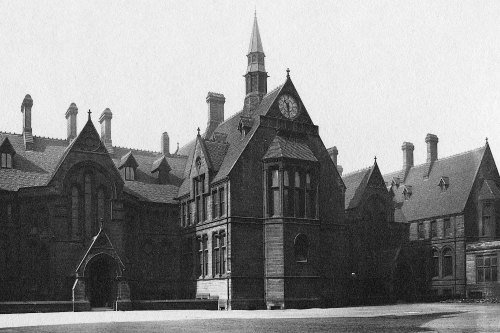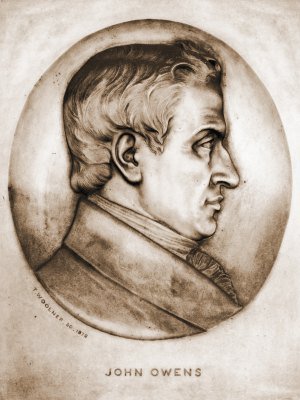The John Owens Building
Named after the originator of Owens College, one of the University's ancestral foundations, the John Owens building originally housed all subjects except chemistry and medicine.

In 1851 Owens College opened in a house on Quay Street in central Manchester. It was named for John Owens, an unmarried Manchester merchant and industrialist who had died in 1846. He left most of his fortune to provide "to youths of the age of 14 and upwards instruction in the branches of education taught at English universities, free from religious tests".
The idea of a university college in Manchester was not new and some of Owens's friends were interested. As trustees of Owens's estate they made it happen – but the new college almost failed for want of students. It did not prepare men to be Christian ministers, nor did it include medical students (who were thought to be too coarse), while Manchester businessmen preferred that their sons joined the family business as soon as possible.
The College's fortunes improved from the 1860s as its leaders looked to German universities as a model. In the view of three reformers, research was the key ingredient of higher education, because it advanced knowledge, was a potential source of material benefits, and gave students the experience of facing the unknown.
Henry Roscoe, the Professor of Chemistry, had taken a PhD at Heidelberg under Bunsen (of the Bunsen burner); in Manchester he married into the rich and powerful Potter family (Beatrix Potter, creator of Peter Rabbit, was his niece). Adolphus Ward, the Professor of English and History, had been raised in Germany. Thomas Ashton, a very able textile manufacturer had also studied at Heidelberg; he helped lead the fundraising for the buildings on Oxford Road which opened in 1873 and remain the heart of the University.

The gothic building now named for John Owens was the first on this site. Like all the buildings, it was designed by the Manchester architect Alfred Waterhouse, who in 1868 had won the competition to design a new town hall for Manchester and who later designed the Natural History Museum in London. All the disciplines taught in the new college were accommodated in this main building, except for chemistry, for which Roscoe had a big new institute on Burlington Street, and medical courses, which were taught at the new medical school across the 'back quadrangle' to the east of the main building.
Key teachers in the John Owens building included William Stanley Jevons, who from 1863 to 1876 taught political economy and philosophy; his well-known work The Coal Question was the first to examine our use of natural resources. Ward taught English from 1866 to 1889, and history from 1866 to 1897, and he was for many years the drama critic of the nationally important Manchester Guardian. Osborne Reynolds was appointed in 1868, at the age of 26, to the new professorship in engineering paid for by local industrialists; he is now best known for the Reynolds number, which helps predict the velocity at which the laminar flow of liquid through a pipe becomes turbulent.
In 1880 Owens College became the founding college of the federal Victoria University, which later, and until 1904, included new colleges in Leeds and Liverpool. Between 1880 and 1902 the main quadrangle was completed, including the building for the Manchester Museum and for the council chamber of the Victoria University, the Beyer Building for geology, zoology and botany, the Christie Library, and the fabulous Whitworth Hall.
